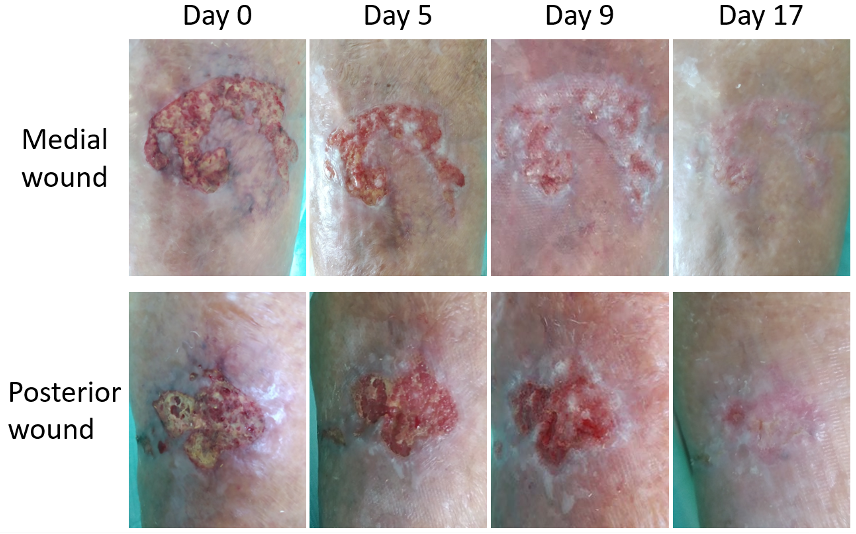References
Bonifant H, Holloway S (2019) A review of the effects of ageing on skin integrity and wound healing. Br J Community Nurs 24(Sup3): S28–S33
Combarros-Fuertes P, Fresno JM, Estevinho MM, Sousa-Pimenta M, Tornadijo ME, Estevinho LM (2020) Honey: another alternative in the fight against antibiotic-resistant bacteria? Antibiotics (Basel) 9(11): 774; doi: 10.3390/antibiotics9110774
Cremers N, Belas A, Santos Costa S, Couto I, de Rooster H, Pomba C (2020) In vitro antimicrobial efficacy of two medical grade honey formulations against common high-risk meticillin-resistant staphylococci and Pseudomonas spp. pathogens. Vet Dermatol 31(2): 90–96
Gosain A, DiPietro LA (2004) Aging and wound healing. World J Surg 28(3): 321–6
Hermanns R, Mateescu C, Thrasyvoulou A, Tananaki C, Wagener FADTG, Cremers NAJ (2020) Defining the standards for medical grade honey. Journal of Apicultural Research 2020; 59(2): 125–35
Leung E, Wongrakpanich S, Munshi MN (2018) Diabetes Management in the Elderly. Diabetes Spectr 31(3): 245–53
Mandal MD, Mandal S (2011) Honey: its medicinal property and antibacterial activity. Asian Pac J Trop Biomed 1(2): 154–60
Molan PC (2002) Re-introducing honey in the management of wounds and ulcers - theory and practice. Ostomy Wound Manage 48(11): 28–40
Nair HKR, Tatavilis N, Pospisilova I, Kucerova J, Cremers NAJ (2020) Medical-grade honey kills antibiotic-resistant bacteria and prevents amputation in diabetics with infected ulcers: a prospective case series. Antibiotics (Basel) 9(9): 529
Pleeging CCF, Coenye T, Mossialos D, et al (2020) Synergistic antimicrobial activity of supplemented medical-grade honey against Pseudomonas aeruginosa biofilm formation and eradication. Antibiotics 9(12): 866
Renáta Zeleníkováa, Dana Vyhlídalováb (2019) Applying honey dressings to non-healing wounds in elderly persons receiving home care. J Tissue Viability; doi: 10.1016/j.jtv.2019.04.002
Sen CK (2019) Human Wounds and Its Burden: An Updated Compendium of Estimates. Adv Wound Care (New Rochelle. 8(2): 39–48
Smaropoulos E, Cremers NAJ (2019) The pro-healing effects of medical grade honey supported by a pediatric case series. Complement Ther Med 45: 14–18
Smaropoulos E, Cremers NAJ (2020a) Treating severe wounds in pediatrics with medical grade honey: A case series. Clin Case Rep. 8(3): 469–76
Smaropoulos E, Cremers NA (2020b) Medical grade honey for the treatment of paediatric abdominal wounds: a case series. J Wound Care 29(2): 94–9
Smaropoulos E, Cremers NAJ (2021) Medical grade honey for the treatment of extravasation-induced injuries in preterm neonates – a case series. Advances in Neonatal Care 21(2): 122–32
Stechmiller JK (2010) Understanding the role of nutrition and wound healing. Nutr Clin Pract 25(1): 61–8
Wilkinson HN, Hardman MJ (2020) Wound healing: cellular mechanisms and pathological outcomes. Open Biol 10(9): 200223
Yilmaz AC, Aygin D (2020) Honey Dressing in Wound Treatment: A Systematic Review. Complement Ther Med 51: 102388
Zeleníkováa R, Vyhlídalováb D (2019) Applying honey dressings to non-healing wounds in elderly persons receiving home care. J Tissue Viability; doi: 10.1016/j.jtv.2019.04.002
Combarros-Fuertes P, Fresno JM, Estevinho MM, Sousa-Pimenta M, Tornadijo ME, Estevinho LM (2020) Honey: another alternative in the fight against antibiotic-resistant bacteria? Antibiotics (Basel) 9(11): 774; doi: 10.3390/antibiotics9110774
Cremers N, Belas A, Santos Costa S, Couto I, de Rooster H, Pomba C (2020) In vitro antimicrobial efficacy of two medical grade honey formulations against common high-risk meticillin-resistant staphylococci and Pseudomonas spp. pathogens. Vet Dermatol 31(2): 90–96
Gosain A, DiPietro LA (2004) Aging and wound healing. World J Surg 28(3): 321–6
Hermanns R, Mateescu C, Thrasyvoulou A, Tananaki C, Wagener FADTG, Cremers NAJ (2020) Defining the standards for medical grade honey. Journal of Apicultural Research 2020; 59(2): 125–35
Leung E, Wongrakpanich S, Munshi MN (2018) Diabetes Management in the Elderly. Diabetes Spectr 31(3): 245–53
Mandal MD, Mandal S (2011) Honey: its medicinal property and antibacterial activity. Asian Pac J Trop Biomed 1(2): 154–60
Molan PC (2002) Re-introducing honey in the management of wounds and ulcers - theory and practice. Ostomy Wound Manage 48(11): 28–40
Nair HKR, Tatavilis N, Pospisilova I, Kucerova J, Cremers NAJ (2020) Medical-grade honey kills antibiotic-resistant bacteria and prevents amputation in diabetics with infected ulcers: a prospective case series. Antibiotics (Basel) 9(9): 529
Pleeging CCF, Coenye T, Mossialos D, et al (2020) Synergistic antimicrobial activity of supplemented medical-grade honey against Pseudomonas aeruginosa biofilm formation and eradication. Antibiotics 9(12): 866
Renáta Zeleníkováa, Dana Vyhlídalováb (2019) Applying honey dressings to non-healing wounds in elderly persons receiving home care. J Tissue Viability; doi: 10.1016/j.jtv.2019.04.002
Sen CK (2019) Human Wounds and Its Burden: An Updated Compendium of Estimates. Adv Wound Care (New Rochelle. 8(2): 39–48
Smaropoulos E, Cremers NAJ (2019) The pro-healing effects of medical grade honey supported by a pediatric case series. Complement Ther Med 45: 14–18
Smaropoulos E, Cremers NAJ (2020a) Treating severe wounds in pediatrics with medical grade honey: A case series. Clin Case Rep. 8(3): 469–76
Smaropoulos E, Cremers NA (2020b) Medical grade honey for the treatment of paediatric abdominal wounds: a case series. J Wound Care 29(2): 94–9
Smaropoulos E, Cremers NAJ (2021) Medical grade honey for the treatment of extravasation-induced injuries in preterm neonates – a case series. Advances in Neonatal Care 21(2): 122–32
Stechmiller JK (2010) Understanding the role of nutrition and wound healing. Nutr Clin Pract 25(1): 61–8
Wilkinson HN, Hardman MJ (2020) Wound healing: cellular mechanisms and pathological outcomes. Open Biol 10(9): 200223
Yilmaz AC, Aygin D (2020) Honey Dressing in Wound Treatment: A Systematic Review. Complement Ther Med 51: 102388
Zeleníkováa R, Vyhlídalováb D (2019) Applying honey dressings to non-healing wounds in elderly persons receiving home care. J Tissue Viability; doi: 10.1016/j.jtv.2019.04.002




